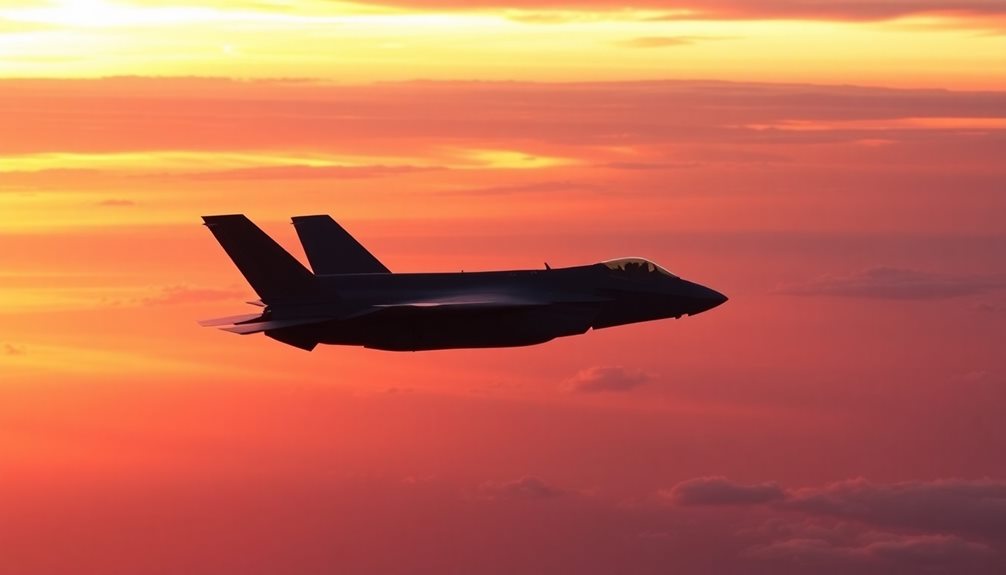The F-35 Lightning II integrates cutting-edge technology that transforms modern air combat. Its stealth features minimize radar detection, enhancing survivability. Advanced sensors like the Electro-Optical Targeting System (EOTS) and Distributed Aperture System (DAS) provide superior situational awareness, letting you track multiple threats effortlessly. Capable of speeds up to Mach 1.6 with a combat range over 1,350 miles, this aircraft is built for a variety of missions. Plus, its high-tech systems reduce pilot workload, making operations more efficient. You'll discover even more about its innovative capabilities and impacts on air defense as you explore further.
Key Takeaways
- The F-35 integrates stealth technology, minimizing its radar cross-section to evade detection during missions.
- Advanced sensors like EOTS and DAS provide superior situational awareness and threat detection.
- The AN/APG-81 AESA radar offers high-resolution imaging and multitarget tracking capabilities.
- Real-time data sharing and fusion enhance decision-making and reduce pilot workload during operations.
- The F-35's design includes three variants, catering to diverse operational needs and environments.
Introduction

When it comes to modern air combat, the F-35 Lightning II stands out as a game-changer. This multirole fighter integrates cutting-edge technology that not only enhances its survivability but also significantly boosts national security.
With advanced sensors like the Electro-Optical Targeting System (EOTS) and the Distributed Aperture System (DAS), the F-35 provides you with unparalleled situational awareness, allowing you to detect and engage threats effectively.
The stealth technology incorporated into the F-35's design minimizes its radar cross-section, making it harder for enemies to track. This unique combination of shape and internal weapon bays ensures that you can approach missions with a reduced risk of detection.
Capable of reaching speeds of Mach 1.6 and boasting a combat radius of over 1,350 miles, the F-35 can execute diverse missions ranging from ground attack to aerial reconnaissance.
Moreover, the F-35 program fosters global partnerships, supporting over 254,000 high-paying jobs in the U.S. It represents a significant leap in aerospace and defense technology, ensuring that you're equipped with the best tools for modern warfare.
The F-35 Lightning II truly embodies the future of air combat.
Background

The F-35 Joint Strike Fighter emerged from a pressing need to modernize aging U.S. jet fighter inventories, focusing on advanced stealth capabilities for enhanced survivability. Developed by Lockheed Martin, the F-35 Lightning II represents a significant leap forward in military aircraft technology. Its design process began in the early 1990s, incorporating lessons learned from decades of stealth technology evolution.
The F-35 features three variants: Conventional Takeoff and Landing (CTOL), Carrier Variant (CV), and Short Take-Off and Vertical Landing (STOVL). Each variant shares key performance characteristics while addressing different operational requirements.
The aircraft integrates sophisticated aircraft systems, providing unparalleled situational awareness through advanced sensors and data fusion capabilities. This significantly reduces the operational workload for pilots compared to previous generations of fighters.
To ensure mission readiness, extensive training programs have prepared over 2,000 pilots and 14,000 maintainers worldwide. High-fidelity simulators play a critical role, accounting for nearly 50% of qualifying flights.
This comprehensive approach guarantees that operators are well-equipped to leverage the F-35's advanced stealth capabilities and maintain its edge in contested environments.
Advanced Sensor Package Features

Building on the F-35's advanced design, its sensor package stands out as a game-changer in modern aerial combat. The F-35 Lightning II features an advanced sensor package that includes the Electro-Optical Targeting System (EOTS), providing precision targeting capabilities while significantly enhancing situational awareness for pilots.
Coupled with the Electro-Optical Distributed Aperture System (DAS), the aircraft offers 360-degree awareness, detecting and tracking incoming threats with ease. Coupled with the Electro-Optical Distributed Aperture System (DAS), the aircraft offers 360-degree awareness, detecting and tracking incoming threats with ease. This advanced capability not only enhances pilot survivability but also provides unparalleled situational intelligence in the most complex combat scenarios. Additionally, the aircraft’s cutting-edge design and agility enable it to perform some of the world’s most thrilling aerial displays, showcasing its precision and unmatched versatility both in tactical operations and at airshows worldwide.
Moreover, the F-35's advanced sensors enable real-time data sharing and fusion, allowing you to make informed decisions based on a comprehensive battlefield picture. The robust AN/APG-81 AESA radar enhances this capability, delivering high-resolution imaging and multitarget tracking. This is critical for identifying and engaging multiple adversaries efficiently.
Perhaps most importantly, the sensor suite's capabilities reduce pilot workload by automating data collection and analysis. This automation not only enhances mission effectiveness but also improves operational efficiency, allowing you to focus on strategic maneuvers rather than managing overwhelming amounts of information.
With these cutting-edge features, the F-35 Lightning II sets a new standard for aerial superiority.
Public Enthusiasm for Innovation

As advances in military aviation technology continue to unfold, public enthusiasm for innovations like the F-35 fighter jet is palpable. The F-35 Lightning II represents a remarkable leap in advanced technology, captivating your interest with its stealth capabilities and integrated sensor systems.
With over 40,000 flight hours logged by F-35 pilots, the operational readiness of this aircraft reinforces the commitment to national security that resonates with you.
Moreover, the economic growth generated by the F-35 program, which supports over 254,000 high-paying jobs in the U.S., highlights the tangible benefits of defense innovation. This not only fosters a sense of pride in domestic advancements but also sparks curiosity about the future of military aviation.
International collaboration on the F-35 project showcases global partnerships in technological innovation, further fueling your enthusiasm for enhanced defense capabilities.
The advanced training systems, including high-fidelity simulators for F-35 pilots, underscore the dedication to innovation in defense training that appeals to your interest in military operations.
Together, these elements create a vibrant narrative of progress and excitement surrounding the F-35 Lightning II, embodying a future where technology and security converge.
Career Opportunities in Aerospace

In the dynamic landscape of aerospace, career opportunities abound, particularly in relation to the F-35 program. This initiative supports over 254,000 high-paying jobs in the U.S., reflecting the immense potential within the aerospace sector. With its contributions to advanced engineering, manufacturing, and technology, the F-35 program plays a pivotal role in sustaining not only defense capabilities but also economic growth. As this sector continues to expand, it draws talent from diverse fields, offering exciting career prospects even for those who traditionally may not have considered aerospace—just as varied backgrounds have catapulted some of the biggest reality TV stars to unexpected fame. The aerospace industry’s reach now influences both national security and entertainment, showcasing that innovation drives success in all arenas. With the ever-increasing intersection of technology and creativity, the aerospace sector’s innovation parallels other industries, such as entertainment, where character evolution drives engagement. Much like **ensemble stars character development** creates captivating stories that draw in diverse audiences, the collaborative efforts within aerospace are essential for fueling advancement and long-term success. As these fields overlap, both industries thrive on fostering teamwork, innovation, and the growth of individual talent.
As you consider your future, training and development programs for F-35 pilots and maintainers stand out, with around 2,000 pilots and over 14,000 maintainers trained from ten different countries.
The aerospace industry thrives on international collaborations, offering diverse roles in engineering, manufacturing, and maintenance. The F-35 program drives high-tech aerospace advancements, creating a growing demand for skilled professionals in crucial fields like cybersecurity, software development, and avionics.
Job creation linked to the F-35 not only enhances workforce development but also strengthens local economies through partnerships with educational institutions and training organizations.
Frequently Asked Questions
What Makes the F-35 so Special?
The F-35's unique stealth design, advanced sensor fusion, and 360-degree situational awareness make it exceptional. You'll appreciate how it engages adversaries undetected, enhancing your combat effectiveness and ensuring you have superior mission capabilities.
What Is the Most Feared Fighter Jet in the World?
When you think about the most feared fighter jet, the F-35 often comes to mind. Its advanced stealth, speed, and technology give it a significant advantage, making it a formidable opponent in any conflict.
How Fast Is the F-35 in Mph?
You'll be impressed to know the F-35 reaches speeds of about 1,200 miles per hour. This supersonic capability, combined with advanced stealth features, makes it a formidable presence in the skies during missions.
Is F-35 Better Than F-22?
You can't definitively say the F-35 is better than the F-22; it depends on mission requirements. The F-35 offers versatility and advanced sensors, while the F-22 excels in speed and air superiority. Each has unique strengths.









